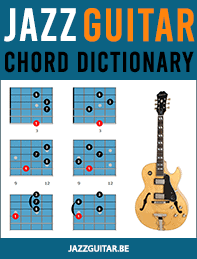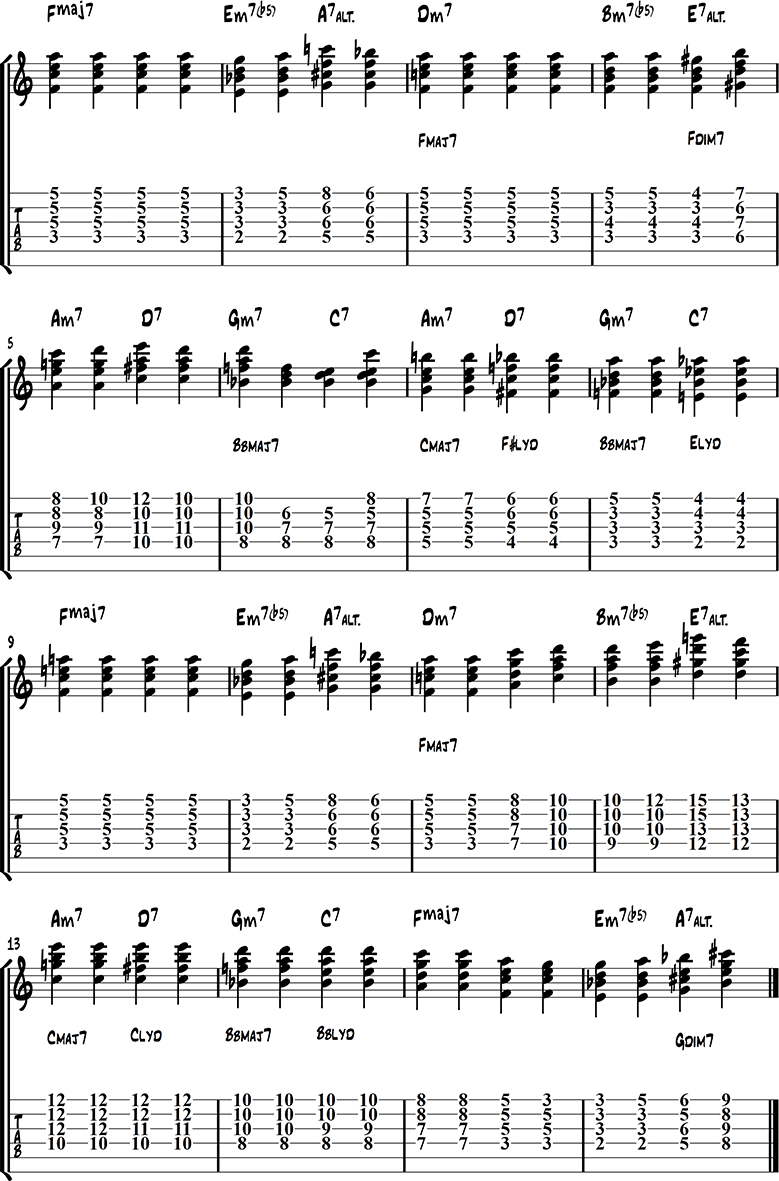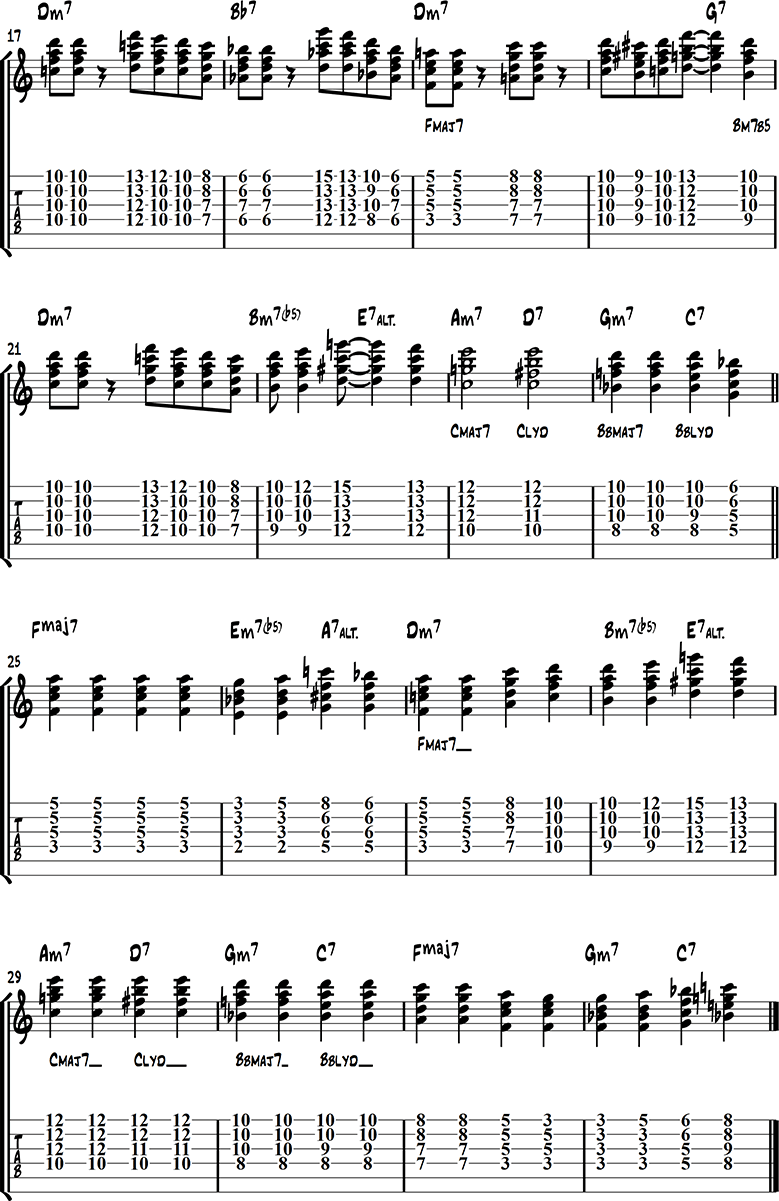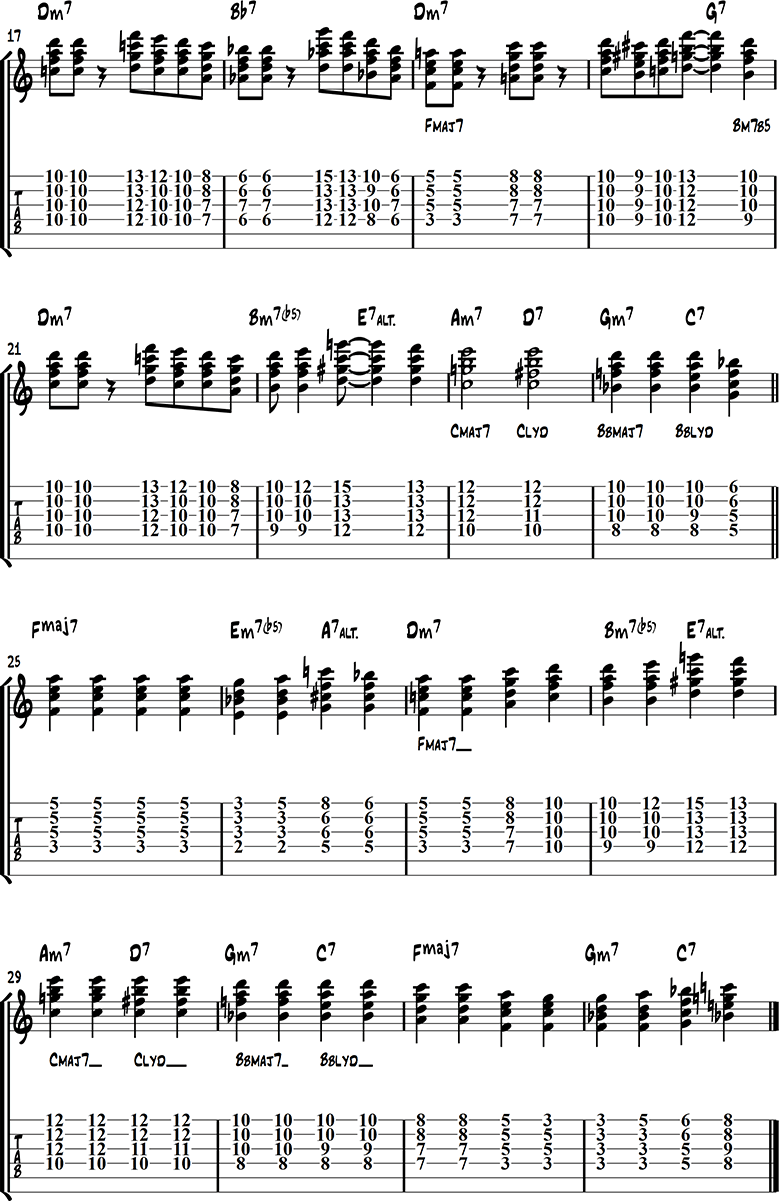One of the most popular jazz standards of all time, Georgia on My Mind is a favorite vehicle for jazz guitarists of all levels of experience. With a memorable melody, engaging chord progression, and a slow bluesy feel, Georgia is a great tune to jam on in a solo, duo, or combo setting.
In this lesson, you’ll learn how to play the chords of Georgia on My Mind by getting a chord study under your fingers.
Not only with this study help you learn to play Georgia, it will also expand your chord knowledge, build your rhythm chops, and increase your guitar technique all in one study.

THE JAZZ GUITAR CHORD DICTIONARY (FREE eBOOK)
Download now and learn 244 chord shapes!
What’s in This Georgia on My Mind Guitar Chords Study
Before you learn how to play the Georgia chord study, here’s a bit of background on important elements used in the etude below. If you find that you enjoy any of these concepts, feel free to take them out of the study and expand upon them in your practice routine.
Lastly, if you have any questions about these concepts or anything in the study, share them in the comments section below.
Rhythms
The main rhythm used in this study is a quarter-note pulse.
Mostly associated with Freddie Green, quarter note comping is a bit different in a ballad setting such as this. You don’t have to accent the 2 and 4 as much as you would when using quarter notes at faster tempos.
Once you get the hang of the steady rhythm, you can experiment with anticipating the quarter notes by playing them an 8th-note early.
In the bridge section, there are more 8th notes and rests used to break up the quarter-note pulse set in the other sections of the study. When you reach a bridge section, it’s often a good idea to change your rhythmic approach to signify that it’s a change in the form, as you do in the study below.
3 to 9 Chords
These chords are common chord substitutions found in jazz guitar and are used by every great jazz guitarist.
To build a 3 to 9 chord, you play one chord (such as Fmaj7) over the underlying chord (Dm7) to create the interval pattern 3-5-7-9.
- Dm9 = D F A C E
- Fmaj7 = F A C E (b3 5 b7 9 of Dm7)
You can see these being used with the Fmaj7 over Dm7, Cmaj7 over Am7, and Bm7b5 over G7 in the study below.
Lydian Subs 1
The first Lydian sub you’ll see is playing a maj7#11 chord from the b7 of any dominant 7th chord.
When doing so, you create a rootless 13th sound over the underlying chord.
An example of this would be playing Bbmaj7#11 over C7. The notes of Bbmaj7#11 (Bb-D-E-A) produce the intervals b7-9-3-13 over C7.
So, whenever you are comping, and you see a 7th chord, just play a maj7#11 one tone down from that chord to build a rootless 13th sound in your playing.
Lydian Subs 2
The second Lydian sub is when you play a maj7#11 chord from the 3rd of a dominant 7th chord.
When doing so, you create a 7(#9,#5) sound in the underlying chord.
For example, if you play F#maj7#11 (F#, A#, C, F) over D7, you get the intervals 3, #5, b7, #9.
If you ever have a 7th chord, you can play a maj7#11 from the 3rd to create a 7 altered sound over that underlying chord.
4th Chords
These are chords built by stacking 4th intervals, compared to the traditional stacking of 3rds you are used to seeing and playing.
Quartal chords tend to sound more modern, but they can be used in bebop and more traditional jazz genres as well.
An example of this chord is the Fmaj7 in bar 15, where you’re playing A-D-G-C, all four notes stacked in 4th intervals on top of each other.
Drop 2 Chords
Most of the chords in this study are drop 2 chords played on the top four strings.
Drop 2 chords are built with the interval pattern 1-5-7-3, and all inversions built up from there.
Because they’re on consecutive strings and can be played in the upper range of the guitar, these shapes are great when playing in a combo setting, or any setting with a bass player.
Georgia on My Mind Guitar Chord Study
Now that you have some background info on what’s in this study, here’s the chord etude. Take your time, working it in 2, 4, or 8-bar phrases as needed until you’re ready to play the study as a whole.
There’s a backing track included below, bass and drums only, that you can use to practice along.
Backing Track
Listen & Play Along





Basic question, but how are you fingering the first chords in bar 5?
Hey man, this is such a great lesson. I’m super new to guitar, and this is pretty much my first standard.
Great stuff! Thx!
Los acordes del 1 al 16 o la A y A’, no aparecen a conciencia o es una errata, la pista si empieza en A. Me extraña que sea éste el primer comentario al respecto.se inicia en acorde/barra 17 y luego se repite.
Gracias por el trabajo que haceis.
great work to get people like me love to learn about jazz. though its more about understanding the concepts, you are talking about, I still miss the script of the first eight bars of your listn&playalong.
Wow…great lesson…takes a lot of practice to make smooth transitions!
Hey Dirk – I’m unable to download Georgia On My Mind. When I do it says :
“Something goes wrong, you don’t have permission to use this page, sorry.”
Is it possible to get a copy I can download straight from you?
Thanks for everything!
Would appreciate this great arrangement with its melody
O K
You say that a Bbmaj7#11 chord has the notes Bb-D-E-A, but where’s the 5th (F)?
Wouldn’t Bbmaj7(b5) be a more accurate name?
Hey. Good question. there aren’t enough fingers to include both the #11 and 5th, so we take out the 5th to make the #11 chord playable. Hope that helps.
I had to re-visit this lesson and re-study it.Dirk and Matt you guys are awesome for everything you have given all of us!I have learned so much I can’thank you enough!
Herzlichen Dank!
Das hätte ich sonst nie herausgefunden!
What is a Clyd and Bbyd chord in bar 13 & 14?
Hey, if you look above the study at Lydian Subs 1 and 2 you’ll find the description there. Cheers.
My real first time at learning a jazz number, awsome, thank you
These comping etudes and everything else you have provided are great lessons!I have learned so much and can now improvise my own comping etudes over a lot of the standards.With the help of you guys I can now sell 75 percent of my guitar books/cds and dvds on ebay.Your website just gets better and better.Thank you so much,and keep up the good work.
i sent it twice. sorry. i didn’t think my first one went thru. i am just seeing you reply now. let me take a look and thank you for everything!
Bar 18 is a real killer! Any suggestions on the best way to train the fingers to make the chord transitions smoothly? I am going over the bar slowly and methodically. At tempo, it’s still a little sloppy. I’m determined! ;o(
Hi Bill, did you see my comment about the fingerings on your last post. Did that help?
Bar 18 is a killer! Any suggested practice methods to go from (1string up) 13-13-13-12 to 10-9-10-8?
Hey
Try this, should help make it much easier
xx12-13-13-13 = xx1222
xx8-10-9-10 = xx1324
A great lesson .. At first I thought: Do I can not! But after 10 minutes I then yet begun and am thrilled. Harmony on a quite high level. Thank you very much!
Your name in itself is a PREMIUM QUALITY JAZZ GUITAR LESSON TRADEMARK!! You should register it!!
Cheers, that’s Dirk playing in the video. If you ever see a video of a fingerstyle guy that’s me.
Hello Matt!
Very nice chord arrangement.
A few times already, I have stumbled across this chord to which I am unable to put a name – Bar 6 last chord on 4 high strings from lowest to highest: 8 7 5 8. Can you put a name to this typically Jazz guitar chord? Matt?
A great many thanks for your answer… Bruno
Hey
That is a C9 chord, C E Bb D, So the Root, 3rd, b7 and 9th. Cheers!
You’re just THE BEST! ..and a GENTLEMAN too!
By the way is that a Drop 2 ??
Bruno
Thanks
Glad to help. It’s not a Drop 2. Not really a name for that shape, but I call it the “Ed Bickert 9th Chord” as Ed used it a lot in his playing.
Yeah I saw it too in the excellent Bb Blues played by Emily Remler in the sequence Cm7 Cm7 C#dim C9.
OK that’s how I’ll call it from now on. Or shall I call it the Matt chord (in my mind?
Maybe it’s a chord usually played by jazz pianists and borrowed by jazz guitarists…
One last thing. Is that you playing the Arpeggio Study ‘Misty” on video? Because I noticed the alternating picking technique used on it and other vids also.
Keep on doing the excellent work that is yours Matt!!
Your name in itself is a PREMIUM QUALITY GUITAR JAZZ TRADEMARK!! You should register it!!
Thanks so much Matt.
Bruno
Just great! Challenging and worth every minute (hour) of work. To play along with the backing track is just so exciting. I feel I am really playing the legit stuff. Thank you!.
class! thanks for a wonder lesson
This was a great lesson. Where can I find or purchase more lessons like this ?
Thanks
https://www.jazzguitar.be/blog/category/guitar-chords/
Hi Matt & Dirk
Thank you for yet another great useful lesson , i would echo the earlier request from Leyland
for a follow up with some ideas fpr soloing over these changes please.
I have downloaded the Book 2 , but regret time constraints haven’t allowed time yet to look
at it at length.
regards
Alan
Great song, Great arrangement
Absolute excellence! Time and work to compose this lesson, time and work to master it! I’ve heard it said that genius is 1% talent and 99% work. Alright geniuses, let’s get busy. I hope there’s a modernized jazz solo in the works to be presented in the future, to compliment this comp arrangement. Thanks you guys!
Very nice. Thanks a lot !!
Universal
Dear Dirk, this is exactly the kind of lesson that really helps the beginning and intermediate player understand how the music works. Every time I open my mail box and see your email, I smile. Many thanks again. You just do not even begin to understand what an invaluable help you provide to us lesser mortals trying to maneuver our way through the dark and often treacherous waterways of Jazz music.
Great!!.
Thank you Dirk very nice piece
How can I download this lesson?
Hey, just click on the picture of the study and then click print.
Working on the lesson now, and finding it super informative and amazing! How would you compare this lesson to those offered in your new 30 day jazz book?
Thanks, glad you dig it. This is about the medium level lessons in the 30 days book, there are 3 levels for each lesson, beginner, medium, advanced. The lessons in the book are more about creating these sorts of coming styles, but there are studies and examples like this as well.
please how can i download all these lessons so i can practice them offline? thanks
Hey, just click on the picture of the study and then click print.
I love all of this song, specially the tempo.
Thanks a lot Dirk.
Great idea, Leland Isley. How does the ii/V7 Bebop lay over the 3 to 9 arpeggiated sub. If you could point the studies in this I would certainly dig that!
Sweet
It would great to see a follow up lesson with some solo strategies for the these changes and substitutions
one of my fav’s!! and nice to have another way to play it. i was at a jazz workshop some time ago, and the tutor played this on sax in a Ray Charles style.
the bass player came in on the ‘B’ the drummer and me on guitar took the hint, it ended up sounding real good.a lovely moment.thank you for all your generous work.
The first time I listened this song was through Steve Winwood with Spencer Davis Group, Great song, thank you.
Absolutely beautiful! It’s going to keep me busy for some time in order to play this smoothly but it’s going to be well worth it! Many thanks!
You guys are awesome! Thanks
Thanks, these lessons are really well constructed.
Wonderful!
A nice variation thanks
Great Lesson! Thank you
Great example to be studied! thanks.
Anyway I note your examples are often based on higher strings, I wold great appreciate if you may you also provide patterns based on 5th and 6th string.
thanks again.
Yes, I find some of those chords quite difficult, as I’m a relative beginner in jazz, playing on a classical guitar without a cutaway. I guess it’s up to us, Antonio, to transcribe the chords down a few notches for ourselves – a good challenge!
Thanks again, Dirk. A great old song, beautifully arranged.
Seems to me that these voicings are meant to be played with a bass player, which makes the lack of 6/5th string roots make sense.
Cheers,
A Very Nice flow and Progession of Chords..
Thank you very very much!!!
Nice.
Thanks Dirk.
Another great lesson. Thanks.
great job
Thanx
Thank you Dirk, another gem as usual, creative yet accessible, you continue to be the best.
dkw
Thank you
Great lesson. Learned a lot Thanks
Thanks a lot